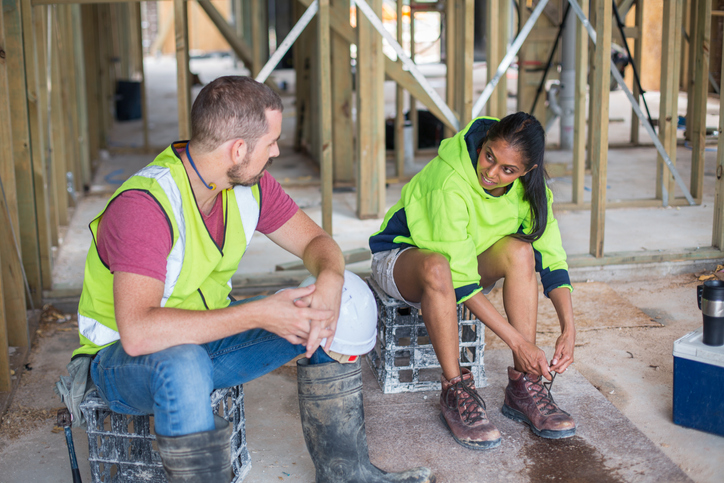Builders blueprint calls for end to bias in construction industry to meet demand
The Australian construction sector has to become more flexible and open to change to address ‘critical shortages’ in workers, industry body says
Australia will need almost half a million people to enter the construction industry in the next three years to meet demand, Master Builders Australia said.
The MBA just released its plan to draw more people to the sector, Future-proofing Construction: A Workforce Blueprint, to address ‘critical shortages’ with the potential to hinder economic recovery and productivity growth.
MBA CEO Denita Wawn said the blueprint outlines pathways to retaining existing workers and removing biases that deter young people from entering the industry.
“To address the bias pushing young people toward university at the expense of VET. Critically, this includes improving the quality of careers education in secondary and senior secondary schools,” she said.
“The construction industry attracts more male than female workers. Improving the attractiveness of the industry to women presents a massive opportunity to increase the pool of potential workers.
“Governments are urged to tackle these issues as a key aspect of the inflationary challenge facing our industry.”
Master Builders Australia estimates that 486,000 workers will be needed to enter the industry by the end of 2026 to allow for those leaving the building sector and future growth projections.
Ms Wawn said it was critical that the industry provide more flexible pathways for workers to reflect the changing nature of work and meet future demand in construction.
“Construction is the backbone of the Australian economy, employing approximately 1.3 million people, providing infrastructure, commercial and community buildings, and homes for the growing population,” Denita Wawn. “With Australia’s population projected to grow by over 50 per cent between 2022 and 2060, reaching nearly 40 million people, the industry will require a significant workforce to undertake the necessary building and construction work.”
This stylish family home combines a classic palette and finishes with a flexible floorplan
Just 55 minutes from Sydney, make this your creative getaway located in the majestic Hawkesbury region.
A Sydney site with a questionable past is reborn as a luxe residential environment ideal for indulging in dining out
Long-term Sydney residents always had handful of not-so-glamourous nicknames for the building on the corner of Cleveland and Baptist Streets straddling Redfern and Surry Hills, but after a modern rebirth that’s all changed.
Once known as “Murder Mall” or “Methadone Mall”, the 1960s-built Surry Hills Shopping Centre was a magnet for colourful characters and questionable behaviour. Today, however, a $500 million facelift of the site — alongside a slow and steady gentrification of the two neighbouring suburbs — the prime corner property has been transformed into a luxury apartment complex Surry Hills Village by developer Toga Group.
The crowning feature of the 122-apartment project is the three-bedroom penthouse, fully completed and just released to market with a $7.5 million price guide.
Measuring 211sqm of internal space, with a 136sqm terrace complete with landscaping, the penthouse is the brand new brainchild of Surry Hills local Adam Haddow, director of architecture at award-winning firm SJB.
Victoria Judge, senior associate and co-interior design lead at SJB says Surry Hills Village sets a new residential benchmark for the southern end of Surry Hills.
“The residential offering is well-appointed, confident, luxe and bohemian. Smart enough to know what makes good living, and cool enough to hold its own amongst design-centric Surry Hills.”
Allan Vidor, managing director of Toga Group, adds that the penthouse is the quintessential jewel in the crown of Surry Hills Village.
“Bringing together a distinct design that draws on the beauty and vibrancy of Sydney; grand spaces and the finest finishes across a significant footprint, located only a stone’s throw away from the exciting cultural hub of Crown St and Surry Hills.”
Created to maximise views of the city skyline and parkland, the top floor apartment has a practical layout including a wide private lobby leading to the main living room, a sleek kitchen featuring Pietra Verde marble and a concealed butler’s pantry Sub-Zero Wolf appliances, full-height Aspen elm joinery panels hiding storage throughout, flamed Saville stone flooring, a powder room, and two car spaces with a personal EV.
All three bedrooms have large wardrobes and ensuites with bathrooms fittings such as freestanding baths, artisan penny tiles, emerald marble surfaces and brushed-nickel accents.
Additional features of the entertainer’s home include leather-bound joinery doors opening to a full wet bar with Sub-Zero wine fridge and Sub-Zero Wolf barbecue.
The Surry Hills Village precinct will open in stages until autumn next year and once complete, Wunderlich Lane will be home to a collection of 25 restaurants and bars plus wellness and boutique retail. The EVE Hotel Sydney will open later in 2024, offering guests an immersive experience in the precinct’s art, culture, and culinary offerings.
The Surry Hills Village penthouse on Baptist is now finished and ready to move into with marketing through Toga Group and inquiries to 1800 554 556.
This stylish family home combines a classic palette and finishes with a flexible floorplan
Just 55 minutes from Sydney, make this your creative getaway located in the majestic Hawkesbury region.























